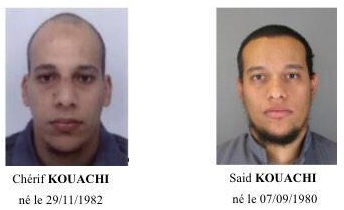
French officials have identified three suspects as being responsible for the terrorist attack on Charlie Hebdo, a French satirical magazine, earlier today. And at least one of them has long been tied to al Qaeda’s international network.
A pair of brothers, Said Kouachi and Cherif Kouachi, have been named as suspects, according to the Associated Press (AP). A third suspect has been named as Hamyd Mourad; he later surrendered to police. The Kouachi brothers are in their 30s while Mourad is 18 years old.
According to USA Today, French police revealed during a press conference that the Kouachis were “born in Paris of Algerian descent” and had “returned from Syria this summer.”
Cherif Kouachi was part of the so-called “19th arrondissement network,” which sent jihadist recruits off to fight for al Qaeda in Iraq and its first emir, Abu Musab al Zarqawi, who was killed in 2006. French officials first conducted raids against the “19th arrondissement network” in 2005, imprisoning some of its members. Cherif Kouachi was convicted on terror-related charges for his role in the network and, in 2008, sentenced to three years in prison.
Investigators are currently looking into the Kouachi brothers’ foreign ties, including their possible links to al Qaeda or the Islamic State, an al Qaeda offshoot that claims to rule much of Iraq and Syria as a “caliphate.”
Thus far, the following details point to ties between the terrorists and al Qaeda. “You can tell the media that it’s al Qaeda in Yemen,” one of the attackers said during the assault, according to a witness cited in the press. At least one other witness has corroborated this account, saying the attackers claimed allegiance to al Qaeda.
The terrorists’ reference to “al Qaeda in Yemen” is really another way of saying al Qaeda in the Arabian Peninsula (AQAP), al Qaeda’s official branch in Saudi Arabia and Yemen. The emir of AQAP, Nasir al Wuhayshi, is also al Qaeda’s global general manager. AQAP has explicitly threatened Charlie Hebdo and its editor-in-chief, Stephane Charbonnier, who was killed in today’s attack.
The 10th issue of AQAP’s Inspire magazine, which was released last year, includes a “Wanted” poster that is headlined, “Dead or Alive For Crimes Against Islam.” The poster is intended to encourage followers to shoot 11 people, all of whom have supposedly offended Islam. One of them is Charbonnier. [See LWJ report, Analysis: Al Qaeda and other jihadists repeatedly threatened French magazine.]
A French official who briefed the press earlier today also claimed that the terrorists are “linked to a Yemeni terrorist network.”
Although ties between the Kouachi brothers and AQAP have not been definitively established, their recent travel to Syria, if confirmed, could have provided them with the opportunity to work with al Qaeda’s Yemeni branch.
AQAP assigned some of its key personnel to the so-called Khorasan group, which is based in Syria and led by senior al Qaeda operatives. The US Government launched airstrikes against the Khorasan group last September, and officials justified the bombings by pointing to its planned attacks in the West.
One of the Khorasan operatives targeted in the bombings is David Drugeon, an al Qaeda bomb maker who is from France.
There are possible links to the Islamic State as well. The Kouachi brothers’ contacts in Syria are not known, but they could have met with Islamic State members.
At least one prominent member of the “19th arrondissement network,” which Cherif Kouachi was convicted of belonging to, has joined the Islamic State. In December, a Tunisian jihadist named Boubaker el Hakim appeared in a pro-Islamic State video that was posted online. El Hakim also claimed responsibility for the assassinations of two Tunisian opposition politicians during the video.
In July 2013, Tunisian authorities implicated el Hakim in the assassinations, which the officials said were ordered by the leader of Ansar al Sharia Tunisia, Abu Iyad al Tunisi. Tunisian officials pointed to el Hakim’s jihadist experience in Iraq as one of the reasons he was considered so dangerous. [See LWJ report, Tunisian government alleges longtime jihadist involved in assassinations.]
El Hakim was convicted alongside Cherif Kouachi by a French court in 2008. Both of them belonged to the “19th arrondissement network,” and surely knew one another.
It is not known if Cherif Kouachi has maintained any ties to Boubaker el Hakim in the years since.
On social media, followers of both AQAP and the Islamic State are claiming that the Charlie Hebdo attack was the work of their respective organizations.








4 Comments
He went to jail on terrorism charges. He went to Syria. The French government let him back in the country. Who are those with blood on their hands?
It was not a terrorist attack, as declared Holland.
Terror identifies by the other way in the Freanch as well as in US legislation.
The Illegal use of weapons, killing based o the religious motive is a better desription of the event.
Moreover, the suspects did not declare any revenge, as all official (religious) media had declared all over the word.
“Open your eyes” on reality!
Looks to be more like an AQ style attack rather than ISIS or a lone wolf. Might be the “khorasan” group. Since this is their goal.
Aryn, you’re dead wrong buddy. Both sets of murderous terrorists called into the news and announced they were from Aqap and ISIS. Not sure if you also missed these SAVAGES screaming that they’ve avenged the honor of the prophet as they ran down the street.